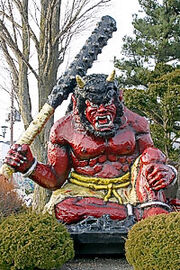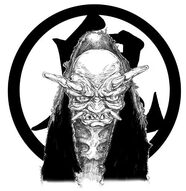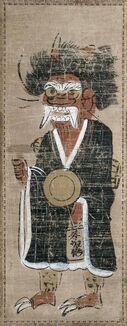No edit summary Tag: rte-wysiwyg |
m (Protected "Oni" ([edit=sysop] (indefinite) [move=sysop] (indefinite))) |
||
| (19 intermediate revisions by 11 users not shown) | |||
| Line 3: | Line 3: | ||
'''Oni''' (鬼, ''Oni'') are a kind of yōkai from Japanese folklore, variously translated as demons, devils, ogres or trolls. They are popular characters in Japanese art, literature and theatre. |
'''Oni''' (鬼, ''Oni'') are a kind of yōkai from Japanese folklore, variously translated as demons, devils, ogres or trolls. They are popular characters in Japanese art, literature and theatre. |
||
| − | Depictions of oni vary widely but usually portray them as hideous, gigantic ogre-like creatures with sharp claws, wild hair, and two long horns growing from their heads. They are humanoid for the most part, but occasionally, they are shown with unnatural features such as odd numbers of eyes or extra fingers and toes. Their skin may be any number of colors, but red and blue are particularly common. |
+ | Oni are one the greatest icons of Japanese folklore. Depictions of oni vary widely but usually portray them as hideous, gigantic ogre-like creatures with sharp claws, wild hair, and two long horns growing from their heads. They are humanoid for the most part, but occasionally, they are shown with unnatural features such as odd numbers of eyes or extra fingers and toes. Their skin may be any number of colors, but red and blue are particularly common. They wear loincloths made of the pelts of great beasts. All oni possess extreme strength and constitution, and many of them are also accomplished sorcerers. They are ferocious demons, bringers of disaster, spreaders of disease, and punishers of the damned in Hell. |
They are often depicted wearing tiger-skin loincloths and carrying iron clubs called ''kanabō'' (金棒). This image leads to the expression "oni with an iron club" (鬼に金棒, ''oni-ni-kanabō''), that is, to be invincible or undefeatable. It can also be used in the sense of "strong beyond strong", or having one's natural quality enhanced or supplemented by the use of some tool. |
They are often depicted wearing tiger-skin loincloths and carrying iron clubs called ''kanabō'' (金棒). This image leads to the expression "oni with an iron club" (鬼に金棒, ''oni-ni-kanabō''), that is, to be invincible or undefeatable. It can also be used in the sense of "strong beyond strong", or having one's natural quality enhanced or supplemented by the use of some tool. |
||
| Line 12: | Line 12: | ||
The invisible oni eventually became anthropomorphized and took on its modern, ogre-like form, partly via syncretism with creatures imported by Buddhism, such as the Indian ''rakshasa'' and ''yaksha'', the hungry ghosts called ''gaki'', and the devilish underlings of Enma-Ō who punish sinners in Jigoku (Hell).They share many similarities with the Arabian Jinn. |
The invisible oni eventually became anthropomorphized and took on its modern, ogre-like form, partly via syncretism with creatures imported by Buddhism, such as the Indian ''rakshasa'' and ''yaksha'', the hungry ghosts called ''gaki'', and the devilish underlings of Enma-Ō who punish sinners in Jigoku (Hell).They share many similarities with the Arabian Jinn. |
||
| − | ==Demon Gate== |
||
Another source for the ''oni's'' image is a concept from China and Onmyōdō. The northeast direction was once termed the ''kimon'' (鬼門, "demon gate"), and was considered an unlucky direction through which evil spirits passed. Based on the assignment of the twelve zodiac animals to the cardinal directions, the ''kimon'' was also known as the ''ushitora'' (丑寅), or "Ox Tiger" direction, and the ''oni's'' bovine horns and cat-like fangs, claws, and tiger-skin loincloth developed as a visual depiction of this term. |
Another source for the ''oni's'' image is a concept from China and Onmyōdō. The northeast direction was once termed the ''kimon'' (鬼門, "demon gate"), and was considered an unlucky direction through which evil spirits passed. Based on the assignment of the twelve zodiac animals to the cardinal directions, the ''kimon'' was also known as the ''ushitora'' (丑寅), or "Ox Tiger" direction, and the ''oni's'' bovine horns and cat-like fangs, claws, and tiger-skin loincloth developed as a visual depiction of this term. |
||
Temples are often built facing that direction, and Japanese buildings sometimes have L-shaped indentions at the northeast to ward oni away. Enryakuji, on Mount Hiei northeast of the center of Kyoto, and Kaneiji, in that direction from Edo Castle, are examples. The Japanese capital itself moved northeast from Nagaoka to Kyoto in the 8th century. |
Temples are often built facing that direction, and Japanese buildings sometimes have L-shaped indentions at the northeast to ward oni away. Enryakuji, on Mount Hiei northeast of the center of Kyoto, and Kaneiji, in that direction from Edo Castle, are examples. The Japanese capital itself moved northeast from Nagaoka to Kyoto in the 8th century. |
||
| + | |||
| + | ==Behavior== |
||
| + | [[File:Onidemon.jpg|thumb|186px|Oni]]Oni are born when truly wicked humans die and end up in one of the many Buddhist Hells, transformed into Oni. They become the ogreish and brutal servants of Great Lord Enma, ruler of Hell, wielding iron clubs with which they crush and destroy humans solely for enjoyment. An oni’s job is to mete out horrible punishments such as peeling off skin, crushing bones, and other torments too horrible to describe to those who were wicked (but not quite wicked enough to be reborn as demons themselves). Hell is full of oni, and they make up the armies of the great generals of the underworld. |
||
| + | |||
| + | Occasionally, when a human is so utterly wicked that his soul is beyond any redemption, he transforms into an oni during life, and remains on Earth to terrorize the living. These transformed oni are the ones most legends tell about, and the ones who pose the most danger to humankind. |
||
| + | |||
| + | These oni are the stuff of legends and fairy tails, countless stories of lords and ladies, warriors and rogues that make up Japanese mythology. No two stories about oni are exactly alike except for one thing: oni are always the villains of mankind. |
||
==Traditional culture== |
==Traditional culture== |
||
| Line 49: | Line 55: | ||
==Known oni== |
==Known oni== |
||
| − | [[Rokurokubi]] |
+ | [[Rokurokubi]]<br /> |
| + | [[Hashihime]]<br /> |
||
| − | |||
| − | [[ |
+ | [[Shinigami]]<br /> |
| ⚫ | |||
| − | |||
| ⚫ | |||
| − | [[Shini\gami]] |
||
| + | [[Tearai-Oni]]<br /> |
||
| − | |||
| + | [[Gozu]]<br /> |
||
| ⚫ | |||
| + | [[Mezu]]<br /> |
||
| − | |||
| ⚫ | |||
==References== |
==References== |
||
*[https://en.wikipedia.org/wiki/Oni Oni] on Wikipedia |
*[https://en.wikipedia.org/wiki/Oni Oni] on Wikipedia |
||
| + | *[http://yokai.com/oni/ Oni] on Yokai.com |
||
[[Category:Types of yōkai]] |
[[Category:Types of yōkai]] |
||
Revision as of 00:26, 23 November 2019

Oni
Oni (鬼, Oni) are a kind of yōkai from Japanese folklore, variously translated as demons, devils, ogres or trolls. They are popular characters in Japanese art, literature and theatre.
Oni are one the greatest icons of Japanese folklore. Depictions of oni vary widely but usually portray them as hideous, gigantic ogre-like creatures with sharp claws, wild hair, and two long horns growing from their heads. They are humanoid for the most part, but occasionally, they are shown with unnatural features such as odd numbers of eyes or extra fingers and toes. Their skin may be any number of colors, but red and blue are particularly common. They wear loincloths made of the pelts of great beasts. All oni possess extreme strength and constitution, and many of them are also accomplished sorcerers. They are ferocious demons, bringers of disaster, spreaders of disease, and punishers of the damned in Hell.
They are often depicted wearing tiger-skin loincloths and carrying iron clubs called kanabō (金棒). This image leads to the expression "oni with an iron club" (鬼に金棒, oni-ni-kanabō), that is, to be invincible or undefeatable. It can also be used in the sense of "strong beyond strong", or having one's natural quality enhanced or supplemented by the use of some tool.
Origins
The word "oni" is sometimes speculated to be derived from on, the on'yomi reading of a character (隠) meaning to hide or conceal, as oni were originally invisible spirits or gods which caused disasters, disease, and other unpleasant things. These nebulous beings could also take on a variety of forms to deceive (and often devour) humans. Thus the Chinese character 鬼 (pinyin: guǐ; Jyutping: gwai2) meaning "ghost" came to be used for these formless creatures.
The invisible oni eventually became anthropomorphized and took on its modern, ogre-like form, partly via syncretism with creatures imported by Buddhism, such as the Indian rakshasa and yaksha, the hungry ghosts called gaki, and the devilish underlings of Enma-Ō who punish sinners in Jigoku (Hell).They share many similarities with the Arabian Jinn.
Another source for the oni's image is a concept from China and Onmyōdō. The northeast direction was once termed the kimon (鬼門, "demon gate"), and was considered an unlucky direction through which evil spirits passed. Based on the assignment of the twelve zodiac animals to the cardinal directions, the kimon was also known as the ushitora (丑寅), or "Ox Tiger" direction, and the oni's bovine horns and cat-like fangs, claws, and tiger-skin loincloth developed as a visual depiction of this term.
Temples are often built facing that direction, and Japanese buildings sometimes have L-shaped indentions at the northeast to ward oni away. Enryakuji, on Mount Hiei northeast of the center of Kyoto, and Kaneiji, in that direction from Edo Castle, are examples. The Japanese capital itself moved northeast from Nagaoka to Kyoto in the 8th century.
Behavior

Oni
Oni are born when truly wicked humans die and end up in one of the many Buddhist Hells, transformed into Oni. They become the ogreish and brutal servants of Great Lord Enma, ruler of Hell, wielding iron clubs with which they crush and destroy humans solely for enjoyment. An oni’s job is to mete out horrible punishments such as peeling off skin, crushing bones, and other torments too horrible to describe to those who were wicked (but not quite wicked enough to be reborn as demons themselves). Hell is full of oni, and they make up the armies of the great generals of the underworld.
Occasionally, when a human is so utterly wicked that his soul is beyond any redemption, he transforms into an oni during life, and remains on Earth to terrorize the living. These transformed oni are the ones most legends tell about, and the ones who pose the most danger to humankind.
These oni are the stuff of legends and fairy tails, countless stories of lords and ladies, warriors and rogues that make up Japanese mythology. No two stories about oni are exactly alike except for one thing: oni are always the villains of mankind.
Traditional culture

Oni in pilgrim's clothing. Tokugawa period. Hanging scroll, ink and color on paper. 59.2 cm x 22.1 cm
Some villages hold yearly ceremonies to drive away oni, particularly at the beginning of Spring. During the Setsubun festival, people throw soybeans outside their homes and shout "Oni wa soto! Fuku wa uchi!" ("鬼は外!福は内!", " Oni go out! Blessings come in!"). Monkey statues are also thought to guard against oni, since the Japanese word for monkey, saru, is a homophone for the word for "leaving". Folklore has it that holly can be used to guard against Oni. In Japanese versions of the game tag, the player who is "it" is instead called the "oni".
In more recent times, oni have lost some of their original wickedness and sometimes take on a more protective function. Men in oni costumes often lead Japanese parades to ward off any bad luck, for example. Japanese buildings sometimes include oni-faced roof tiles called onigawara (鬼瓦), which are thought to ward away bad luck, much like gargoyles in Western tradition.
Oni are prominently featured in the Japanese children's story Momotaro (Peach Boy), and the book The Funny Little Woman.
Many Japanese idioms and proverbs also make reference to oni. For example, the expression oya ni ninu ko wa oni no ko (親に似ぬ子は鬼の子) means literally "a child that does not resemble its parents is the child of an oni," but it is used idiomatically to refer to the fact that all children naturally take after their parents, and in the odd case that a child appears not to do so, it might be because the child's true biological parents are not the ones who are raising the child. Depending on the context in which it is used, it can have connotations of "children who do not act like their parents are not true human beings," and may be used by a parent to chastise a misbehaving child. Variants of this expression include oya ni ninu ko wa onigo (親に似ぬ子は鬼子) and oya ni ninu ko wa onikko (親に似ぬ子は鬼っ子). There is also a well known game in Japan called kakure oni (隠れ鬼), which means "hidden oni", or more commonly kakurenbo, which is the same as the hide-and-seek game that children in western countries play.
Popular culture
- In Capcom's video game saga Onimusha where the protagonist wields the power of the Oni, and retell the History of Japan with supernatural elements.
- In Rumiko Takahashi's Urusei Yatsura, the female lead, Lum Invader, is an oni alien depicted wearing a tiger-skin bikini and the entire alien race to which she belongs is fashioned after the classical concept of oni.
- Chie Shinohara's manga Ao no Fuuin uses oni as a main theme when the female protagonist is a descendant of a beautiful oni queen who wants to resurrect her kind.
- Takahashi's Ranma 1/2 features a story in which one of the characters, Kasumi Tendo, is possessed by an oni, causing her to behave in uncharacteristically "evil" (yet humorous) ways.
- The Touhou Project series of shoot-'em-up games has a character named Suika Ibuki, an oni with a massive gourd on her back capable of producing an endless amount of sake; legend has it that no one has seen her sober in her 700-year life. A later game in the series marked the appearance of Yuugi Hoshiguma, Suika's oni associate from a group of four incredibly powerful oni that they both belong to, called the "Four Devas of the Mountains." Yuugi, despite being as great a drinker as Suika while being just as cheerful, is even less of a lightweight than Suika, being able to enter into a fight without seeming intoxicated or even spilling any of the sake in her sake dish.
- In the Mortal Kombat universe, the denizens of the Netherrealm (the series' equivalent of hell) are called Oni (though they represent a drastic deviation from the Japanese concept, being primitive ape-like demons), and the oni character Drahmin's right arm is replaced by a metal club. Another Oni fighter of the series is Moloch.
- In Dragon Ball and Dragon Ball Z, an Oni called King Yemma runs the Check-In Station in Other World, where he decides which souls go to Heaven and which to Hell.
- The Onis are featured in Season 4 of Jackie Chan Adventures. Tarakudo (voiced by Miguel Ferrer) is the King of the Onis. There are 9 other Oni masks that when worn, the demon trapped in the masks can take over the users well-being and able to control their own tribe of the Shadowkhan.
- In Hellboy: Sword of Storms, Hellboy fought a giant Oni. Before the final blow can be struck with the Sword of Storms, the Oni fades away so that Hellboy can break the Sword of Storms on the statue releasing the brothers Thunder and Lightning.
- Kamen Rider Hibiki, a Japanese tokusatsu series, uses Oni (which is what the Kamen Riders here are referred as) as a main theme of the series. It tells the story about ancient battle between the Oni and the Makamou. In another popular tokusatsu, the Ultra series, it is not uncommon for Oni to appear and do battle with an Ultraman.
- Hyakujuu Sentai Gaoranger, Ogre Tribe Org is the main antagonist to fight the Gaorangers and Power Animals.
- In The Venture Brothers season two episode "I Know Why the Caged Bird Kills", Dr. Venture is haunted by a floating Oni which has followed him from Japan.
- In the video game Muramasa: The Demon Blade, Oni are one of the various enemies the main characters battle.
- In Rumiko Takahashi's manga InuYasha, Oni are common Yokai in the series.
- In the first-person shooter series Shadow Warrior, the protagonist is fighting demonic entities that bear a strong resemblance to Onis.
- The 'Oni' are a form of Samurai inspired NPCs (Non Playable Characters) in Crystal Dynamics' 2013 video game release Tomb Raider.
- In the MMORPG "Onigiri" the player's character is an 'Oni'
- In the third season of Teen Wolf Oni appear.
- In Super Street Fighter IV: Arcade Edition a more powerful "unleashed" form of Akuma is named Oni and features claws, fangs, and horns similar to classical depictions of oni.
- In Yo-Kai Watch, many of the creatures found are based on oni. Oni themselves appear as a class of boss enemies. They are distinct between each other, but all have horns. Some also have either claws, horns, or both.
Known oni
Rokurokubi
Hashihime
Shinigami
Tsurube-Otoshi
Amanojaku
Tearai-Oni
Gozu
Mezu
